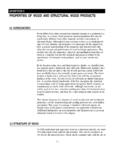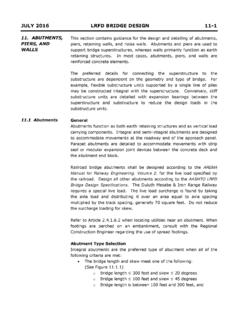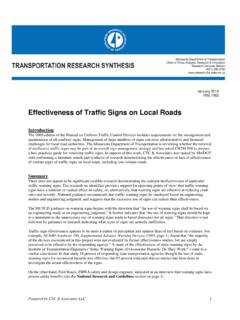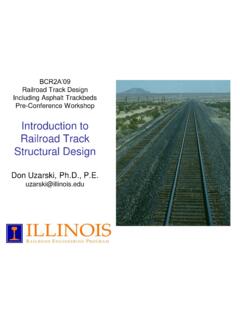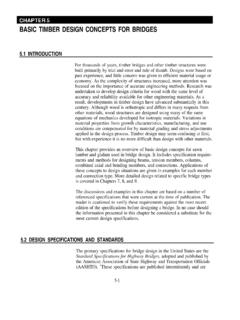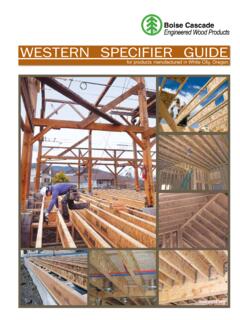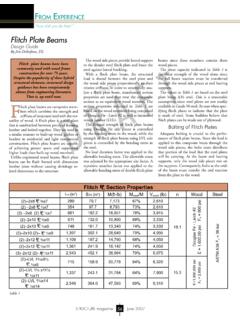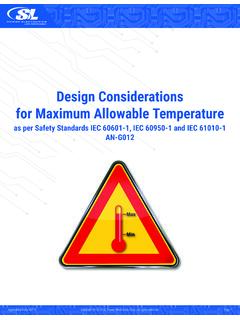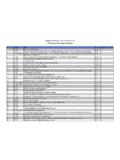Transcription of BASIC TIMBER DESIGN CONCEPTS FOR BRIDGES
1 BASIC TIMBER DESIGN CONCEPTS FOR BRIDGES INTRODUCTION For thousands of years, TIMBER BRIDGES and other TIMBER structures were built primarily by trial and error and rule of thumb. Designs were based on past experience, and little concern was given to efficient material usage or economy. As the complexity of structures increased, more attention was focused on the importance of accurate engineering methods. Research was undertaken to develop DESIGN criteria for wood with the same level of accuracy and reliability available for other engineering materials. As a result, developments in TIMBER DESIGN have advanced substantially in this century. Although wood is orthotropic and differs in many respects from other materials, wood structures are designed using many of the same equations of mechanics developed for isotropic materials.
2 Variations in material properties from growth characteristics, manufacturing, and use conditions are compensated for by material grading and stress adjustments applied in the DESIGN process. TIMBER DESIGN may seem confusing at first, but with experience it is no more difficult than DESIGN with other materials. This chapter provides an overview of BASIC DESIGN CONCEPTS for sawn lumber and glulam used in bridge DESIGN . It includes specification require ments and methods for designing beams, tension members, columns, combined axial and bending members, and connections. Applications of these CONCEPTS to DESIGN situations are given in examples for each member and connection type. More detailed DESIGN related to specific bridge types is covered in Chapters 7, 8, and 9.
3 The discussions and examples in this chapter are based on a number of referenced specifications that were current at the time of publication. The reader is cautioned to verify these requirements against the most recent edition of the specifications before designing a bridge . In no case should the information presented in this chapter be considered a substitute for the most current DESIGN specifications. DESIGN SPECIFICATIONS AND STANDARDS The primary specifications for bridge DESIGN in the United States are the Standard Specifications for Highway BRIDGES , adopted and published by the American Association of State Highway and Transportation Officials (AASHTO). l These specifications are published intermittently and are 5-1 revised annually through the issuance of interim specifications.
4 They address all areas of bridge DESIGN , including geometry, loading, and DESIGN requirements for materials. AASHTO specifications are used extensively as the standard for bridge DESIGN and are the primary reference for the TIMBER DESIGN requirements, procedures, and recommendations addressed in this manual. The majority of the TIMBER DESIGN requirements in AASHTO are based on the National DESIGN Specification for Wood Construction (NDS).26 The NDS is the most widely recognized general specification for TIMBER DESIGN and is published periodically by the National Forest Products Association. The specification includes DESIGN requirements and tabulated DESIGN values for sawn lumber, glulam, and TIMBER piles. Although the NDS does not specifically address detailed bridge DESIGN , it does serve as the basis for the TIMBER DESIGN CONCEPTS and requirements used for BRIDGES .
5 Notation of the NDS as the source of DESIGN requirements in this chapter reflects references in AASHTO that specify the NDS as the most current source of TIMBER DESIGN information for BRIDGES (AASHTO ). In addition to the NDS, AASHTO periodically references the specifica tions, standards, and technical publications of the American Institute of TIMBER Construction (AITC). AITC is the national technical trade associa tion of the glulam industry and is responsible for numerous specifications and technical publications addressing fabrication, DESIGN , and construction of glulam. AITC also publishes AITC 117- DESIGN Standard Specifica tions for Structural Glued Laminated TIMBER of Softwood Species (AITC 117- DESIGN ), which is the source of tabulated values for TIMBER DESIGN requirements for BRIDGES may differ from those commonly used for buildings and other structures.
6 Although the requirements in AASHTO are based on the NDS and other referenced specifications and standards, modifications have been incorporated in AASHTO to address specific bridge requirements. The designer should become familiar with the content and requirements of current AASHTO, NDS, and AITC specifications. Copies of these specifications and other noted references are available from the parent organizations at the addresses listed in Table 16-10. DESIGN METHODS AND VALUES TIMBER BRIDGES are designed according to the principles of engineering mechanics and strength of materials, assuming the same BASIC linear elastic theory applied to other materials. The method used for DESIGN is the allowable stress DESIGN method, which is similar to service load DESIGN for structural steel.
7 In this method, stresses produced by applied loads must be 5-2 SYMBOLS AND ABBREVIATIONS less than or equal to the allowable stresses for the material. A DESIGN method called load and resistance factor DESIGN (LRFD) is used for TIMBER DESIGN in other countries, but not in the United States. Progress is being made toward development of such a method in the United States; how ever, adoption is several years away. As discussed in Chapter 3, wood strength and stiffness vary with species, growth characteristics, loading, and conditions of use. As a result, one set of allowable DESIGN values for all species and DESIGN situations would result in very uneconomical DESIGN in most cases. Conversely, tabulated values for all potential conditions would result in so many tables that they would be unusable.
8 Rather than using either of these approaches, TIMBER DESIGN is based on published tabulated values that are intended for one set of standard conditions. When these conditions differ from those of the DESIGN application, the tabulated values are adjusted by modification factors to arrive at the allowable values used for each DESIGN . This ap proach produces more realistic DESIGN values for a specific situation. In general terms, the BASIC TIMBER DESIGN sequence is as follows: 1. Compute load effects and select an initial member size and species. 2. Compute the applied stress from applied loads. 3. Obtain the tabulated stress published for the specific material. 4. Determine appropriate modification factors and other adjustments required for actual use conditions.
9 5. Adjust the tabulated stress to arrive at the allowable stress used for DESIGN . 6. Compare applied stress to allowable stress. The DESIGN is satisfactory when applied stress is less than or equal to allowable stress. TIMBER DESIGN uses standard symbols to denote the types of stresses for strength properties. These symbols consist of a stress symbol to designate the type of stress (applied, tabulated, or allowable ), followed by a lower case subscript to denote the specific strength property (bending, shear, tension, and so forth). The symbols used for this purpose are shown in Table 5-1. For example, applied, tabulated, and allowable bending stresses are designated fb, Fb, and Fb', respectively. The same type of designation without the strength property subscript applies to modulus of elasticity, where E denotes the tabulated value and E' denotes the allowable value .
10 For glulam, an additional subscript of x or y may be included to designate 5-3 TABULATED DESIGNTABULATED DESIGNVALUESVALUEST able Stress symbols for TIMBER components. values about the x-x or y-y axis of the member (the x-x axis for glulam is always parallel to the wide face of the laminations). For example, Fbx is the tabulated bending stress about the x-x axis. In the absence of such a subscript, it is assumed that stresses act about the x-x axis. Tabulated DESIGN values for sawn lumber and glulam are based on testing and grading processes discussed in Chapter 3. These values represent the maximum permissible values for specific conditions of use and normally require adjustments for actual DESIGN conditions. In this sense, tabulated values should be viewed only as the basis or starting point for determining the allowable values to be used for DESIGN .
